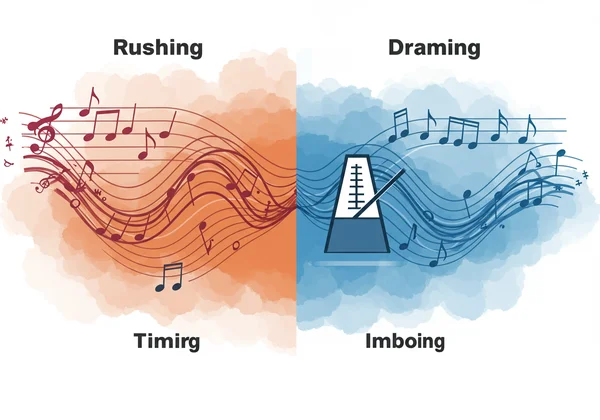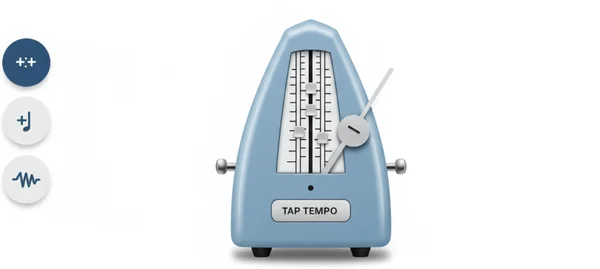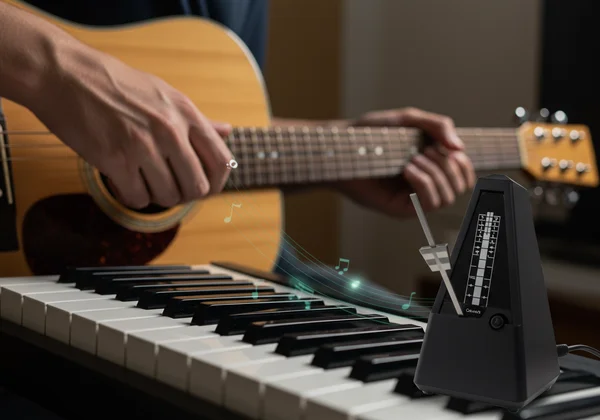Free Metronome Online: Master Your Timing & Overcome Rushing & Dragging
Ever find yourself speeding up or dragging behind the beat? That's rushing or dragging, and it's a common hurdle for musicians, dancers, and even speakers. But here's the good news: you can conquer it! This comprehensive guide will reveal why these common timing flaws occur and provide practical, metronome-driven strategies to help you cultivate unwavering, confident rhythm. Ready to improve your musicality? You can start practicing today with our powerful online metronome.

Understanding Rushing & Dragging: Your Timing Flaws Explained
Before we can fix timing flaws, it’s crucial to understand what they are and why they happen. These rhythmic inconsistencies can throw off an entire performance, making your music sound disjointed or unpolished. Let's dive into the characteristics of each.
What Does Rushing Sound Like in Music?
Rushing happens when you gradually, or sometimes suddenly, speed up beyond the intended tempo. Imagine a train leaving the station slowly, then picking up speed uncontrollably. In music, rushing makes passages sound hurried, frantic, and less precise. It often happens in technically challenging sections, where the performer speeds up due to excitement, anxiety, or simply trying to get through difficult parts too quickly. The notes might sound squashed together, losing their individual clarity and the intended groove.
What Does Dragging Sound Like & Why It Happens?
Conversely, dragging is when you slow down below the intended tempo, causing the music to feel sluggish or heavy. This is like that same train struggling to maintain momentum uphill. Dragging can make music lose its energy and flow, sounding tired or hesitant. It often occurs in passages requiring sustained notes, complex rhythms, or during moments of fatigue. Drummers might struggle to maintain a consistent BPM counter, while guitarists might lag on chord changes. Both rushing and dragging stem from an undeveloped internal sense of rhythm and inconsistent tempo awareness.
Diagnosing Your Timing Issues: Are You Rushing or Dragging?
The first step to overcoming any problem is accurate diagnosis. Are you a chronic rusher, a frequent dragger, or perhaps a bit of both depending on the piece? Pinpointing your specific timing issues will allow you to apply the most effective practice strategies.
The Self-Assessment Test: Record & Listen Back
One of the most effective ways to identify your timing tendencies is to record yourself. Choose a piece you're working on, or even just a simple scale or rhythmic exercise. Play it along with an online metronome set to a comfortable tempo. Then, listen back critically. Pay close attention to how your playing aligns with the metronome's clicks. Does your playing get ahead of the beat (rushing)? Or does it fall behind (dragging)? This honest self-assessment is incredibly insightful for musicians of all levels seeking to improve their musical performance.
Using Our Tap Tempo to Gauge Natural Pace
Sometimes, the issue isn't knowing the target tempo, but understanding your natural pace. Our free metronome online offers a fantastic "Tap Tempo" feature for this very purpose. Simply tap along to a song or a rhythm in your head, and the tap tempo function will calculate the BPM for you. This can reveal your inherent speed tendencies. Are you naturally faster or slower than the average? Understanding your body's innate rhythm can inform your practice, helping you to consciously adjust and work towards a more consistent beat in. Try out this feature and more on our online metronome resource.

How to Stop Rushing Music: Precision Drills with Your Metronome
If you find yourself constantly speeding up, it's time to implement targeted strategies to stop rushing music. Precision and control are your allies here.
The Power of Slow Practice: Building a Solid Foundation
This is perhaps the most fundamental and effective metronome practice technique. Set your metronome online to a significantly slower tempo than your target speed. The idea is to play each note with absolute precision, ensuring perfect synchronization with the metronome clicks. Focus on the space between the notes. This deliberate slowness builds muscle memory for accurate timing and allows you to internalize the consistent beat. Don't be afraid to go extremely slow; quality over speed is the mantra here.
Gradual Tempo Increases: Incremental Progress for Consistency
Once you can play a section perfectly at a slow tempo, gradually increase the speed. Incrementally raise the BPM by small amounts (e.g., 2-5 BPM at a time). Only move up when you can play the passage flawlessly at the current tempo. This slow, steady progression builds endurance and accuracy, solidifying your internal clock and making rushing less likely. It's a systematic approach to mastering speed.
Accent Shifting & Subdivision Focus for Internal Clock Discipline
Our online metronome provides advanced features that are perfect for internal clock discipline. Try using the accent feature to shift the primary accent to different beats within a measure (e.g., emphasizing beat 2 or 4 in a 4/4 measure). This forces you to be hyper-aware of every beat, not just the downbeat. Furthermore, utilizing metronome subdivisions (like eighth notes, sixteenth notes, or triplets) will help you precisely place every single note, preventing you from rushing through the gaps between beats. Our rhythm practice tool allows you to choose from various subdivisions and time signature metronome settings, making complex rhythms approachable. Ready to try? **Set your beat with our versatile tool.

Eliminate Dragging: Metronome Exercises for a Steady Pulse
If dragging is your nemesis, these metronome exercises will help you develop a strong, anticipatory connection to the beat, leading to a steady pulse.
Feeling the "Beat In": Anticipation & Pull Exercises
To combat dragging, you need to learn to feel the beat before you play the note. Practice anticipating the metronome click. Instead of reacting to the click, aim to play with the click, or even slightly ahead of it (without rushing!). Try setting the online metronome at a moderate tempo and playing a simple quarter note rhythm. Focus on feeling the 'pull' of the next beat, preparing your fingers, hands, or voice to land precisely on time. This proactive approach helps build rhythmic awareness.
Rhythmic Awareness: Connecting Your Body & Mind to the Beat
Rhythm isn't just something you hear; it's something you feel deep in your bones. Get your whole body involved in your practice! Tap your foot, sway slightly, or even march in place while playing along with your free metronome. This physical connection to the beat helps solidify your consistent beat. It integrates the rhythm into your muscle memory and enhances your overall musicality. The more you feel the rhythm in your body, the less likely you are to drag.
Practicing with Silent Measures & Subdivision Emphasis
A powerful technique for preventing dragging is practicing with "silent measures." Our online metronome lets you do this by setting a specific number of clicks per measure, then muting some measures. For example, play four measures with clicks, then four measures silently, then four with clicks again. This forces you to maintain the tempo internally, building your internal clock and reducing dependency on the external click. Additionally, practicing with aggressive subdivision emphasis (e.g., playing only the sixteenth notes while the metronome clicks quarter notes) helps you fill the space accurately and eliminates the tendency to slow down between beats. Explore advanced metronome settings to truly master your timing.
Achieving Perfect Rhythm: Integrating the Metronome into Your Practice
Overcoming rushing and dragging isn't a one-time fix; it's a journey. Achieving perfect rhythm requires consistent integration of the metronome into your daily routine.
Consistency is Key: Making Metronome Practice a Daily Habit
Treat your metronome practice like your daily warm-up or a crucial part of your technique development. Even 10-15 minutes a day of focused rhythm practice tool work can yield significant improvements. Make it a non-negotiable part of your routine. The more consistently you engage with the metronome for guitar/piano or any instrument, the faster your timing will improve. Regular practice reinforces good habits and helps you quickly identify and correct any lapses.

Beyond Practice: Applying Your Timing to Performance & Jamming
The ultimate goal of metronome practice is to transfer that precision to your real-world musical scenarios. When performing, even without a metronome, your ingrained internal clock will guide you. During jamming sessions, your reliable timing will make you a more dependable and enjoyable musician to play with. You'll contribute a solid foundation, allowing others to relax and be more creative. Make our online metronome your go-to rhythm practice tool for every session. Start your journey to impeccable timing today!
Embrace the Beat: Start Your Timing Transformation Today
Rushing and dragging are common hurdles, but they are not insurmountable. By understanding their causes, diagnosing your specific tendencies, and applying targeted metronome exercises, you can transform your timing from erratic to impeccable. Our online metronome is your dedicated partner in this journey, offering the features and flexibility you need to achieve perfect rhythm in every note.
Don't let inconsistent timing hold you back any longer. Make a commitment to consistent, smart practice. Access our free metronome now and start building the unwavering rhythmic foundation you've always wanted. Your journey to confident, precise musicality begins with just a click.
Frequently Asked Questions About Metronome Timing
How can a metronome improve my playing and timing?
A metronome provides a consistent, external beat that acts as an objective reference. By practicing with it, you train your internal clock to maintain a steady tempo, helping you avoid rushing or dragging. It also allows you to tackle complex rhythms and technical passages at controlled speeds, improving precision and overall musicality.
What's a good starting tempo for metronome practice?
There's no single "good" starting tempo. The ideal tempo is one where you can play the material perfectly, without mistakes, and with perfect sync to the click. For beginners, this might be very slow, perhaps 40-60 BPM. The key is to start slow and gradually increase the tempo as your accuracy improves. You can easily adjust the BPM counter on our site to find your perfect starting point.
Can I use a metronome to diagnose if I'm rushing or dragging?
Absolutely! The metronome is your best diagnostic tool. By playing along with the online metronome and actively listening to how your notes align with the clicks, you can clearly identify if you are consistently ahead (rushing) or behind (dragging) the beat. Recording yourself while using the metronome can provide even deeper insights into your timing flaws.
How do metronome subdivisions help with steady timing?
Metronome subdivisions break down the main beat into smaller, more granular clicks (e.g., eighth notes, sixteenth notes). This helps you place notes more precisely within the beat, especially when playing faster or more complex rhythms. By hearing and internalizing these smaller divisions, you develop a stronger rhythmic awareness and a more accurate internal clock, which is crucial for preventing both rushing and dragging. Our free metronome online offers a variety of subdivision options for thorough rhythm practice.